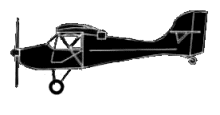
ASN Wikibase Occurrence # 24031
This information is added by users of ASN. Neither ASN nor the Flight Safety Foundation are responsible for the completeness or correctness of this information.
If you feel this information is incomplete or incorrect, you can submit corrected information.
| Date: | Friday 24 August 2001 |
| Time: | 17:30 |
| Type: |  Avid Flyer |
| Owner/operator: | |
| Registration: | 63-KD |
| MSN: | |
| Fatalities: | Fatalities: 0 / Occupants: 2 |
| Aircraft damage: | Substantial |
| Category: | Accident |
| Location: | Les Martres-de-Veyre -
 France France
|
| Phase: | En route |
| Nature: | Training |
| Departure airport: | Montmorillon |
| Ambert | |
| Investigating agency: | BEA |
| Confidence Rating: |
The ULM was cruising at flight level 55, coming from the ULM base of Montmorillon (Vienne) to the airfield of Ambert (Puy-de-Dôme). In order to follow the most direct route possible, the two pilots decided to contact the Clermont-Ferrand approach to obtain the authorization to transit in the south of the TMA (class D space). The controller granted the transit and informed the ULM pilots of the takeoff of two regional aircraft facing east and heading south.
The first one, an Embraer 145 in climb, crossed the route of the ULM at about the same altitude, four or five kilometers ahead. The second aircraft was lost from sight for a few moments by the two pilots of the ultralight and was then found climbing in front of the Avid Flyer. The instructor was about to contact the controller to inform him of the trajectory conflict.
At that moment, the ultralight gradually yawed to the left. The instructor explained that he was trying to counteract this movement by immediately applying right rudder, but the left yaw was accelerating and the ultralight was turning flat. The instructor maintained his right rudder input and pushed the stick forward. The aircraft dived while continuing its rotation to the left. The loss of height was rapid.
The instructor realized that he could not regain control of the aircraft.
He decided to use the emergency parachute and pushed the stick backwards.
The microlight regained a level attitude while still turning. The instructor activated the parachute, which deployed.
The engine was switched off. The aircraft turned slowly one or two turns and stabilized with a flat attitude. The aircraft was now at a height of approximately 250 meters. During the descent the instructor sent two distress messages. After twenty to thirty seconds the aircraft fell into the Allier. The two occupants evacuated the aircraft and swam towards the banks.
The loss of control of the ultralight seems to have been caused by its passage in the wake turbulence of the Embraer 145 crossed at the same altitude.
The deployment of the parachute caused the rupture of the coaxial cable of the radio antenna preventing the transmission of the distress messages.
The ULM was not equipped with a transponder.
Accident investigation:
 |
|
Sources:
https://www.bea.aero/docspa/2001/63-d010824/htm/63-d010824.html
http://www.bea.aero/docspa/2001/63-d010824/pdf/63-d010824.pdf
Revision history:
| Date/time | Contributor | Updates |
|---|---|---|
| 27-Sep-2008 01:00 | ASN archive | Added |
| 17-Nov-2022 18:33 | harro | Updated [Location, Phase, Nature, Departure airport, Destination airport, Damage, Narrative] |
| 18-Nov-2022 14:46 | harro | Updated [[Location, Phase, Nature, Departure airport, Destination airport, Damage, Narrative]] |
Corrections or additions? ... Edit this accident description
The Aviation Safety Network is an exclusive service provided by:


 ©2024 Flight Safety Foundation
©2024 Flight Safety Foundation